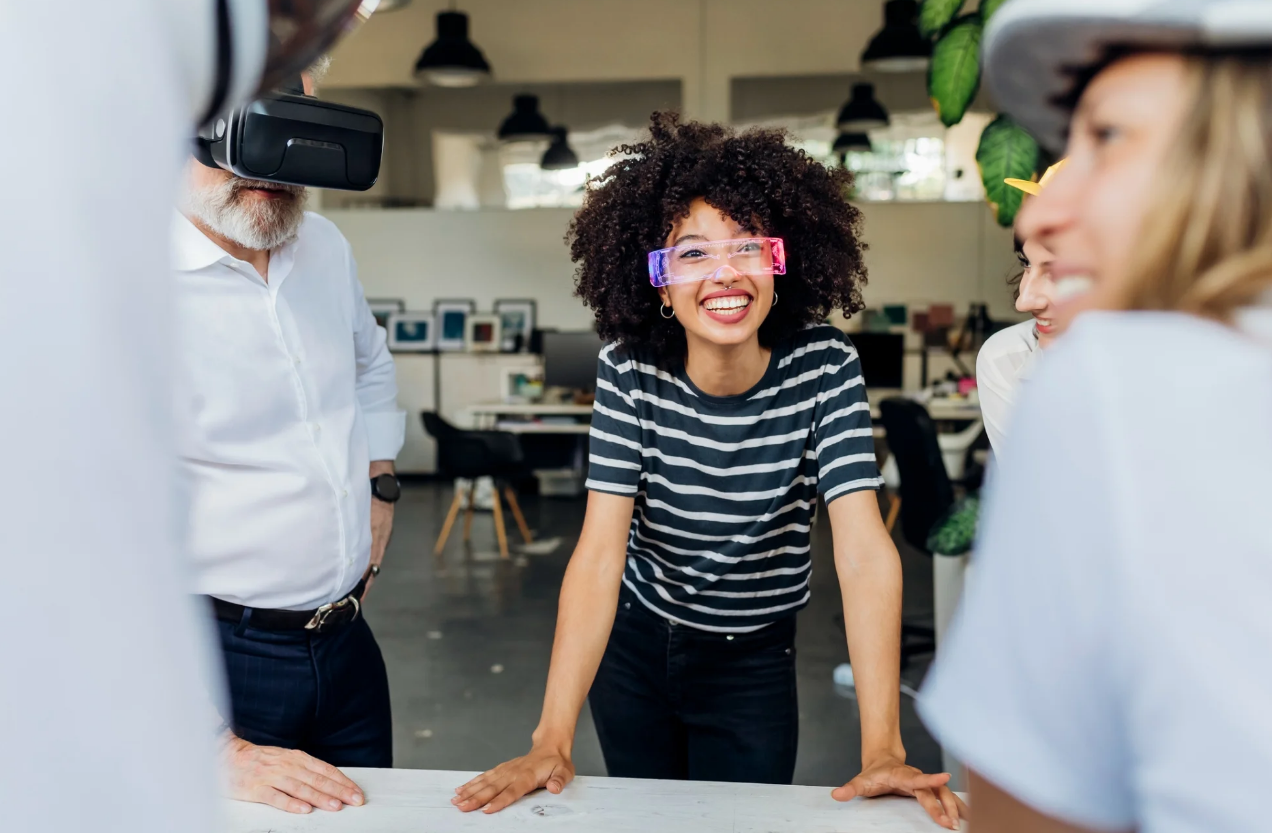While Apple’s Vision Pro is something many heard about, but few experienced, other effective AR glasses exist and are growing increasingly widespread. But how exactly are they transforming our approach to professional tasks and team dynamics?…Story continues…
Source: The Secret Weapon for Crushing Workplace Communication Barriers | Entrepreneur
.
Critics:
Augmented reality (AR) is an interactive experience that combines the real world and computer-generated content. The content can span multiple sensory modalities including visual auditory, haptic, somatosensory and olfactory. AR can be defined as a system that incorporates three basic features: a combination of real and virtual worlds, real-time interaction, and accurate 3D registration of virtual and real objects.
The overlaid sensory information can be constructive (i.e. additive to the natural environment), or destructive (i.e. masking of the natural environment). This experience is seamlessly interwoven with the physical world such that it is perceived as an immersive aspect of the real environment. In this way, augmented reality alters one’s ongoing perception of a real-world environment, whereas virtual reality completely replaces the user’s real-world environment with a simulated one.
Augmented reality is largely synonymous with mixed reality. There is also overlap in terminology with extended reality and computer-mediated reality. The primary value of augmented reality is the manner in which components of the digital world blend into a person’s perception of the real world, not as a simple display of data, but through the integration of immersive sensations, which are perceived as natural parts of an environment.
The earliest functional AR systems that provided immersive mixed reality experiences for users were invented in the early 1990s, starting with the Virtual Fixtures system developed at the U.S. Air Force’s Armstrong Laboratory in 1992. Commercial augmented reality experiences were first introduced in entertainment and gaming businesses. Subsequently, augmented reality applications have spanned commercial industries such as education, communications, medicine, and entertainment.
In education, content may be accessed by scanning or viewing an image with a mobile device or by using markerless AR techniques. Augmented reality is used to enhance natural environments or situations and offers perceptually enriched experiences. With the help of advanced AR technologies (e.g. adding computer vision, incorporating AR cameras into smartphone applications, and object recognition)
The information about the surrounding real world of the user becomes interactive and digitally manipulated. Information about the environment and its objects is overlaid on the real world. This information can be virtual. Augmented Reality is any experience which is artificial and which adds to the already existing reality.
Seeing other real sensed or measured information such as electromagnetic radio waves overlaid in exact alignment with where they actually are in space. Augmented reality also has a lot of potential in the gathering and sharing of tacit knowledge. Augmentation techniques are typically performed in real-time and in semantic contexts with environmental elements.
Immersive perceptual information is sometimes combined with supplemental information like scores over a live video feed of a sporting event.This combines the benefits of both augmented reality technology and heads up display technology (HUD). Hardware components for augmented reality are: a processor, display, sensors and input devices.
Modern mobile computing devices like smartphones and tablet computers contain these elements, which often include a camera and microelectromechanical systems (MEMS) sensors such as an accelerometer, GPS, and solid state compass, making them suitable AR platforms. There are two technologies used in augmented reality: diffractive waveguides and reflective waveguides.
Various technologies are used in augmented reality rendering, including optical projection systems, monitors, handheld devices, and display systems, which are worn on the human body. A head-mounted display (HMD) is a display device worn on the forehead, such as a harness or helmet-mounted. HMDs place images of both the physical world and virtual objects over the user’s field of view.
Modern HMDs often employ sensors for six degrees of freedom monitoring that allow the system to align virtual information to the physical world and adjust accordingly with the user’s head movements. HMDs can provide VR users with mobile and collaborative experiences. Specific providers, such as uSens and Gestigon, include gesture controls for full virtual immersion.
AR displays can be rendered on devices resembling eyeglasses. Versions include eyewear that employs cameras to intercept the real world view and re-display its augmented view through the eyepieces and devices in which the AR imagery is projected through or reflected off the surfaces of the eyewear lens pieces.
A head-up display (HUD) is a transparent display that presents data without requiring users to look away from their usual viewpoints. A precursor technology to augmented reality, heads-up displays were first developed for pilots in the 1950s, projecting simple flight data into their line of sight, thereby enabling them to keep their “heads up” and not look down at the instruments. Near-eye augmented reality devices can be used as portable head-up displays as they can show data, information, and images while the user views the real world.
Many definitions of augmented reality only define it as overlaying the information. This is basically what a head-up display does; however, practically speaking, augmented reality is expected to include registration and tracking between the superimposed perceptions, sensations, information, data, and images and some portion of the real world. Contact lenses that display AR imaging are in development.
These bionic contact lenses might contain the elements for display embedded into the lens including integrated circuitry, LEDs and an antenna for wireless communication.The first contact lens display was patented in 1999 by Steve Mann and was intended to work in combination with AR spectacles, but the project was abandoned, then 11 years later in 2010–2011.
Another version of contact lenses, in development for the U.S. military, is designed to function with AR spectacles, allowing soldiers to focus on close-to-the-eye AR images on the spectacles and distant real world objects at the same time.
Projection mapping augments real-world objects and scenes, without the use of special displays such as monitors, head-mounted displays or hand-held devices. Projection mapping makes use of digital projectors to display graphical information onto physical objects. The key difference in projection mapping is that the display is separated from the users of the system.
Since the displays are not associated with each user, projection mapping scales naturally up to groups of users, allowing for collocated collaboration between users. Examples include shader lamps, mobile projectors, virtual tables, and smart projectors. Shader lamps mimic and augment reality by projecting imagery onto neutral objects.
This provides the opportunity to enhance the object’s appearance with materials of a simple unit—a projector, camera, and sensor. Other applications include table and wall projections. One innovation, the Extended Virtual Table, separates the virtual from the real by including beam-splitter mirrors attached to the ceiling at an adjustable angle.
Virtual showcases, which employ beam splitter mirrors together with multiple graphics displays, provide an interactive means of simultaneously engaging with the virtual and the real. Many more implementations and configurations make spatial augmented reality display an increasingly attractive interactive alternative. A projection mapping system can display on any number of surfaces in an indoor setting at once.
Projection mapping supports both a graphical visualization and passive haptic sensation for the end users. Users are able to touch physical objects in a process that provides passive haptic sensation. Apple could enhance the use of AR for personal shopping and support – with product demos in your living room NotebookCheck.net The XREAL Air glasses are over $100 off for Black Friday Mashable




Leave a Reply